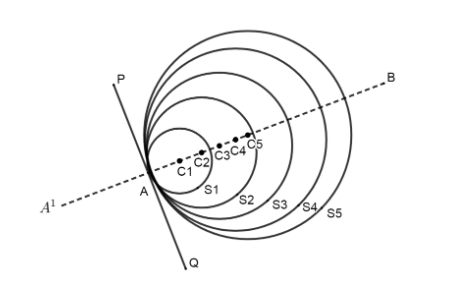
Answer
471k+ views
Hint: To solve this question, we will draw a line and we will draw a number of circles touching that line. After doing this, we will find the focus of the centers of all these circles and then we will answer according to the options given in question
Complete step-by-step answer:
Now, in the question, it is given that a number of circles touch the given line segment at a point. So, we will draw the figure as the information given in question:

Here, in the above figure, we have drawn five circles \[{{\text{S}}_{1}},\text{ }{{\text{S}}_{2}},\text{ }{{\text{S}}_{3}},\text{ }{{\text{S}}_{4}}\text{ and }{{\text{S}}_{5}}\] which has centers \[{{\text{C}}_{1}},\text{ }{{\text{C}}_{2}},\text{ }{{\text{C}}_{3}},\text{ }{{\text{C}}_{4}}\text{ and }{{\text{C}}_{5}}\] the point at which all these circles touch the line segment PQ is A. we can also see from the figure that the centers of circles lie on a straight line. Now, we have to determine the nature of this line. We know that if a line touches a circle at only one point then that line will be the tangent of the circle at that point. In our question, it is given that all the circles touch the line segment PQ at A. Thus the line PQ will be the tangent to all these circles. Now, the line AB passes through the centers of all these circles. It also passes through the point A. Thus the line AB will be normal to all these circles. Thus, we can say that the line \[{{\text{A}}^{1}}\text{B}\]will be perpendicular to line PQ. But here, we do not know anything about the point A i.e. at which position does it lie in the line segment.
Hence, option (D) is correct, because we are not given any information about the point A. If A is the midpoint of the line segment PQ then \[{{\text{A}}^{1}}\text{ B}\] will be a perpendicular bisector otherwise it will be not. So the answer depends on the point on the position of A.
Note: Here, while solving the question, we have considered that the circles lie in the second plane (x-y plane). Even if there is a circle in a third plane (x-y-z plane) and it is touching a given line segment at point A, its center will be on the perpendicular bisector of PQ. Another thing to note is that the radius of the circle has no role in it. Any circle of real radius will satisfy the condition.
Complete step-by-step answer:
Now, in the question, it is given that a number of circles touch the given line segment at a point. So, we will draw the figure as the information given in question:

Here, in the above figure, we have drawn five circles \[{{\text{S}}_{1}},\text{ }{{\text{S}}_{2}},\text{ }{{\text{S}}_{3}},\text{ }{{\text{S}}_{4}}\text{ and }{{\text{S}}_{5}}\] which has centers \[{{\text{C}}_{1}},\text{ }{{\text{C}}_{2}},\text{ }{{\text{C}}_{3}},\text{ }{{\text{C}}_{4}}\text{ and }{{\text{C}}_{5}}\] the point at which all these circles touch the line segment PQ is A. we can also see from the figure that the centers of circles lie on a straight line. Now, we have to determine the nature of this line. We know that if a line touches a circle at only one point then that line will be the tangent of the circle at that point. In our question, it is given that all the circles touch the line segment PQ at A. Thus the line PQ will be the tangent to all these circles. Now, the line AB passes through the centers of all these circles. It also passes through the point A. Thus the line AB will be normal to all these circles. Thus, we can say that the line \[{{\text{A}}^{1}}\text{B}\]will be perpendicular to line PQ. But here, we do not know anything about the point A i.e. at which position does it lie in the line segment.
Hence, option (D) is correct, because we are not given any information about the point A. If A is the midpoint of the line segment PQ then \[{{\text{A}}^{1}}\text{ B}\] will be a perpendicular bisector otherwise it will be not. So the answer depends on the point on the position of A.
Note: Here, while solving the question, we have considered that the circles lie in the second plane (x-y plane). Even if there is a circle in a third plane (x-y-z plane) and it is touching a given line segment at point A, its center will be on the perpendicular bisector of PQ. Another thing to note is that the radius of the circle has no role in it. Any circle of real radius will satisfy the condition.
Recently Updated Pages
Fill in the blanks with suitable prepositions Break class 10 english CBSE

Fill in the blanks with suitable articles Tribune is class 10 english CBSE

Rearrange the following words and phrases to form a class 10 english CBSE

Select the opposite of the given word Permit aGive class 10 english CBSE

Fill in the blank with the most appropriate option class 10 english CBSE

Some places have oneline notices Which option is a class 10 english CBSE

Trending doubts
Fill the blanks with the suitable prepositions 1 The class 9 english CBSE

How do you graph the function fx 4x class 9 maths CBSE

When was Karauli Praja Mandal established 11934 21936 class 10 social science CBSE

Which are the Top 10 Largest Countries of the World?

What is the definite integral of zero a constant b class 12 maths CBSE

Why is steel more elastic than rubber class 11 physics CBSE

Distinguish between the following Ferrous and nonferrous class 9 social science CBSE

The Equation xxx + 2 is Satisfied when x is Equal to Class 10 Maths

Differentiate between homogeneous and heterogeneous class 12 chemistry CBSE




